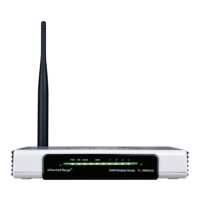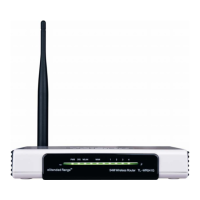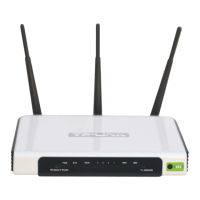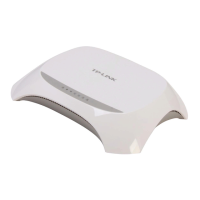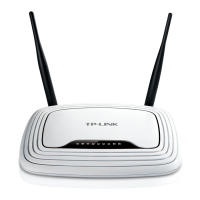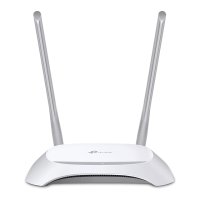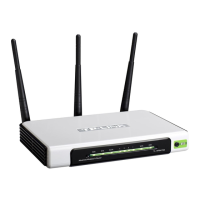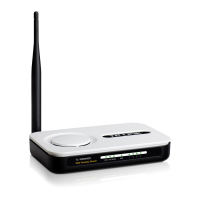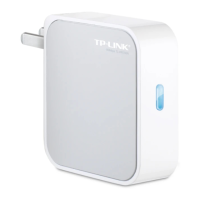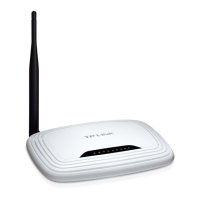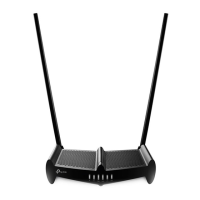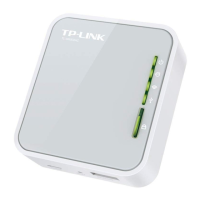Do you have a question about the TP-Link TL-WR543G and is the answer not in the manual?
Describes the TL-WR543G as an integrated wireless router for SOHO environments, supporting AP client and AP router modes.
Lists key features including IEEE standards compliance, ports, operation modes, security, and extended range technology.
Details the LED indicators and components on the front panel of the TL-WR543G router.
Describes the physical ports and buttons on the rear panel, including AC power, LAN ports, WAN port, and reset button.
Outlines the necessary hardware and software components required for setting up the TL-WR543G router.
Specifies the recommended conditions for installing the router, including ventilation, temperature, and humidity.
Provides step-by-step instructions for physically connecting the TL-WR543G router to your network and power source.
Guides on configuring the TCP/IP settings for your PC to establish a connection with the router.
Details the process of accessing the router's web interface and performing initial setup steps like choosing an operation mode.
Explains how to log into the router's web interface and view the status of LAN, Wireless, WAN, and system uptime.
Provides a streamlined process for configuring essential network parameters and initial setup steps.
Allows selection between AP Client Router and AP Router modes to define the device's network role.
Covers configuration of LAN IP parameters, WAN connection types, and MAC Clone.
Configures the router's local area network (LAN) IP address, subnet mask, and MAC address.
Sets up the wide area network (WAN) connection type, including PPPoE, Dynamic IP, Static IP, and other protocols.
Allows cloning a PC's MAC address to the router's WAN port, often required by ISPs.
Manages wireless network settings, including SSID, security types, channel, and mode.
Configures basic wireless parameters like SSID, channel, mode, and security options.
Adjusts advanced wireless parameters such as eXtended Range (XR) and transmit power.
Displays a list of available wireless access points for connection.
Controls wireless client access by filtering based on MAC addresses.
Shows statistics for connected wireless stations, including MAC address and packet counts.
Enables/disables DHCP server, sets IP pools, lease times, and DNS.
Configures the router's DHCP server to assign IP addresses and network parameters to devices.
Displays a list of devices currently connected to the router via DHCP, with their assigned IP and MAC addresses.
Reserves specific IP addresses for LAN devices based on their MAC addresses, ensuring static IP assignment.
Manages port forwarding rules, virtual servers, DMZ host, and UPnP for external access to internal services.
Enables setting up public services by redirecting Internet requests to internal IP addresses and ports.
Manages port triggering rules for applications requiring dynamic port opening.
Exposes a specific local host to the Internet, forwarding all ports to it.
Configures Universal Plug and Play (UPnP) for automatic device discovery and service access.
Manages firewall, IP filtering, domain filtering, MAC filtering, remote management, and advanced security.
Controls the general firewall switch and enables/disables IP, Domain, and MAC filtering rules.
Restricts or allows Internet access based on IP addresses and time constraints.
Controls website access by specifying domain names or keywords to block or allow.
Controls wireless client access by filtering based on MAC addresses.
Configures remote management via Internet by setting a web port and IP address.
Protects against DoS attacks and manages ping packet security.
Defines specific paths for network traffic to reach hosts or networks.
Sets up DDNS to map a fixed domain name to a dynamic IP address.
Guides on configuring DDNS using the Dyndns.org provider.
Guides on configuring DDNS using the Oray.net provider.
Guides on configuring DDNS using the Comexe.cn provider.
Configures Quality of Service (QoS) to prioritize bandwidth for LAN ports and wireless traffic.
Provides access to system tools like Time, Firmware, Factory Defaults, Backup/Restore, Reboot, Password, Log, and Statistics.
Configures the router's system time, time zone, and daylight saving time.
Guides on updating the router's firmware to the latest version.
Resets the router's configuration to its original factory default settings.
Allows saving or restoring the router's configuration file.
Provides a function to restart the router for applying certain settings.
Allows changing the default administrator username and password for security.
Provides access to system logs for monitoring router activity and troubleshooting.
Displays network traffic statistics for LAN PCs, including packet counts and bandwidth usage.
Provides steps for setting up ADSL internet using PPPoE and various connection modes.
Guides on setting up Ethernet internet using Dynamic IP and MAC registration.
Details steps for installing and configuring TCP/IP on a Windows PC for network connectivity.
Explains setting IP addresses automatically or manually for a PC's network connection.
Describes the TL-WR543G as an integrated wireless router for SOHO environments, supporting AP client and AP router modes.
Lists key features including IEEE standards compliance, ports, operation modes, security, and extended range technology.
Details the LED indicators and components on the front panel of the TL-WR543G router.
Describes the physical ports and buttons on the rear panel, including AC power, LAN ports, WAN port, and reset button.
Outlines the necessary hardware and software components required for setting up the TL-WR543G router.
Specifies the recommended conditions for installing the router, including ventilation, temperature, and humidity.
Provides step-by-step instructions for physically connecting the TL-WR543G router to your network and power source.
Guides on configuring the TCP/IP settings for your PC to establish a connection with the router.
Details the process of accessing the router's web interface and performing initial setup steps like choosing an operation mode.
Explains how to log into the router's web interface and view the status of LAN, Wireless, WAN, and system uptime.
Provides a streamlined process for configuring essential network parameters and initial setup steps.
Allows selection between AP Client Router and AP Router modes to define the device's network role.
Covers configuration of LAN IP parameters, WAN connection types, and MAC Clone.
Configures the router's local area network (LAN) IP address, subnet mask, and MAC address.
Sets up the wide area network (WAN) connection type, including PPPoE, Dynamic IP, Static IP, and other protocols.
Allows cloning a PC's MAC address to the router's WAN port, often required by ISPs.
Manages wireless network settings, including SSID, security types, channel, and mode.
Configures basic wireless parameters like SSID, channel, mode, and security options.
Adjusts advanced wireless parameters such as eXtended Range (XR) and transmit power.
Displays a list of available wireless access points for connection.
Controls wireless client access by filtering based on MAC addresses.
Shows statistics for connected wireless stations, including MAC address and packet counts.
Enables/disables DHCP server, sets IP pools, lease times, and DNS.
Configures the router's DHCP server to assign IP addresses and network parameters to devices.
Displays a list of devices currently connected to the router via DHCP, with their assigned IP and MAC addresses.
Reserves specific IP addresses for LAN devices based on their MAC addresses, ensuring static IP assignment.
Manages port forwarding rules, virtual servers, DMZ host, and UPnP for external access to internal services.
Enables setting up public services by redirecting Internet requests to internal IP addresses and ports.
Manages port triggering rules for applications requiring dynamic port opening.
Exposes a specific local host to the Internet, forwarding all ports to it.
Configures Universal Plug and Play (UPnP) for automatic device discovery and service access.
Manages firewall, IP filtering, domain filtering, MAC filtering, remote management, and advanced security.
Controls the general firewall switch and enables/disables IP, Domain, and MAC filtering rules.
Restricts or allows Internet access based on IP addresses and time constraints.
Controls website access by specifying domain names or keywords to block or allow.
Controls wireless client access by filtering based on MAC addresses.
Configures remote management via Internet by setting a web port and IP address.
Protects against DoS attacks and manages ping packet security.
Defines specific paths for network traffic to reach hosts or networks.
Sets up DDNS to map a fixed domain name to a dynamic IP address.
Guides on configuring DDNS using the Dyndns.org provider.
Guides on configuring DDNS using the Oray.net provider.
Guides on configuring DDNS using the Comexe.cn provider.
Configures Quality of Service (QoS) to prioritize bandwidth for LAN ports and wireless traffic.
Provides access to system tools like Time, Firmware, Factory Defaults, Backup/Restore, Reboot, Password, Log, and Statistics.
Configures the router's system time, time zone, and daylight saving time.
Guides on updating the router's firmware to the latest version.
Resets the router's configuration to its original factory default settings.
Allows saving or restoring the router's configuration file.
Provides a function to restart the router for applying certain settings.
Allows changing the default administrator username and password for security.
Provides access to system logs for monitoring router activity and troubleshooting.
Displays network traffic statistics for LAN PCs, including packet counts and bandwidth usage.
Provides steps for setting up ADSL internet using PPPoE and various connection modes.
Guides on setting up Ethernet internet using Dynamic IP and MAC registration.
Details steps for installing and configuring TCP/IP on a Windows PC for network connectivity.
Explains setting IP addresses automatically or manually for a PC's network connection.
| VPN support | PPTP, L2TP, IPSec |
|---|---|
| Ethernet LAN | Yes |
| Cabling technology | 10/100Base-T(X) |
| Networking standards | IEEE 802.11b, IEEE 802.11g, IEEE 802.3 |
| Ethernet LAN data rates | 10, 100 Mbit/s |
| Ethernet LAN interface type | Fast Ethernet |
| Wi-Fi standards | 802.11b, 802.11g |
| Top Wi-Fi standard | 802.11g |
| Input current | 0.6 A |
| Rack mounting | No |
| Frequency band | 2.4 GHz |
| Filtering description | IP, Domain |
| WLAN data transfer rates supported | 11, 54 Mbit/s |
| Ethernet LAN (RJ-45) ports | 4 |
| Security algorithms | 128-bit WEP, 152-bit WEP, 64-bit WEP, WDS, WPA, WPA-PSK, WPA2, WPA2-PSK |
| Transmit power | 0 dBmW |
| Antennas quantity | 1 |
| Antenna gain level (max) | 5 dBi |
| Product color | Black, White |
| Windows operating systems supported | Windows 2000, Windows 2000 Professional, Windows 7 Enterprise, Windows 7 Enterprise x64, Windows 7 Home Basic, Windows 7 Home Basic x64, Windows 7 Home Premium, Windows 7 Home Premium x64, Windows 7 Professional, Windows 7 Professional x64, Windows 7 Starter, Windows 7 Starter x64, Windows 7 Ultimate, Windows 7 Ultimate x64, Windows 98SE, Windows NT, Windows Vista Business, Windows Vista Business x64, Windows Vista Enterprise, Windows Vista Enterprise x64, Windows Vista Home Basic, Windows Vista Home Basic x64, Windows Vista Home Premium, Windows Vista Home Premium x64, Windows Vista Ultimate, Windows Vista Ultimate x64, Windows XP Home, Windows XP Home x64, Windows XP Professional, Windows XP Professional x64 |
| Power source type | AC |
| Storage temperature (T-T) | -40 - 70 °C |
| Operating temperature (T-T) | 0 - 40 °C |
| Storage relative humidity (H-H) | 5 - 90 % |
| Operating relative humidity (H-H) | 10 - 90 % |
| Certification | CE, FCC, RoHS |
| Depth | 111 mm |
|---|---|
| Width | 174 mm |
| Height | 30 mm |
| Weight | - g |
